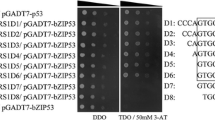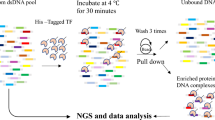Abstract
AtMYB44 is a member of the R2R3 MYB subgroup 22 transcription factors and regulates diverse cellular responses in Arabidopsis thaliana. We performed quadruple 9-merbased protein binding microarray (PBM) analysis, which revealed that full-size AtMYB44 recognized and bound to the consensus sequence AACnG, where n represents A, G, C or T. The consensus sequence was confirmed by electrophoretic mobility shift assay (EMSA) with a truncated AtMYB44 protein containing the N-terminal side R2R3 domain. This result indicates that the R2R3 domain alone is sufficient to exhibit AtMYB44 binding specificity. The sequence AACnG is the type I binding site for MYB transcription factors, including all members of the subgroup 22. EMSA showed that the R2R3 domain protein binds in vitro to promoters of randomly selected Arabidopsis genes that contain the consensus binding sequence. This implies that AtMYB44 binds to any promoter region that contains the consensus sequence, without determining their functional activity or specificity. The C-terminal side transcriptional activation domain of AtMYB44 contains an asparagine-rich fragment, NINNTTSSRHNHNN (aa 215-228), which, among the members of subgroup 22, is unique to AtMYB44. A transcriptional activation assay in yeast showed that this fragment is included in a region (aa 200–240) critical for the ability of AtMYB44 to function as a transcriptional activator. We hypothesize that the C-terminal side of the protein, but not the N-terminal side of the R2R3 domain, contributes to the functional activity and specificity of AtMYB44 through interactions with other regulators generated by each of a variety of stimuli.
Similar content being viewed by others
References
Das, P.K., Shin, D.H., Choi, S.-B., and Park, Y.-I. (2012). Sugarhormone cross-talk in anthocyanin biosynthesis. Mol. Cells 34, 501–507.
Elchinger, L., Pachebat, J.A., Glöckner, G., Rajandream, M.-A., Sucgang, R., Berriman, M., Song, J., Olsen, R., Szafranski, K., Xu, Q., et al. (2005). The genome of the social amoeba Dictyostelium discoideum. Nature 435, 43–57.
Gietz, D., St Jean, A., Woods, R.A., and Schiestl, R.H. (1992). Improved method for high efficiency transformation of intact yeast cells. Nucleic Acids Res. 20, 1425.
Howe, K.M., and Watson, R.J. (1991). Nucleotide preferences in sequence-specific recognition of DNA by c-myc protein. Nucleic Acids Res. 19, 3913–3919.
Howe, K.M., Reakes, C.F.L., and Watson, R.J. (1990). Characterization of the sequence-specific interaction of mouse c-myb protein with DNA. EMBO J. 9, 161–169.
Jin, H., and Martin, C. (1999). Multifunctionality and diversity within the plant MYB-gene family. Plant Mol. Biol. 41, 577–585.
Jung, C., Seo, J.S., Han, S.W., Koo, Y.J., Kim, C.H., Song, S.I., Nahm, B.H., Choi, Y.D., and Cheong, J.-J. (2008). Overexpression of AtMYB44 enhances stomata closure to confer abiotic stress tolerance in transgenic Arabidopsis. Plant Physiol. 146, 623–635.
Jung, C., Shim, J.S., Seo, J.S., Lee, H.Y., Kim, C.H., Choi, Y.D., and Cheong, J.-J. (2010). Non-specific phytohormonal induction of AtMYB44 and suppression of jasmonate-responsive gene activation in Arabidopsis thaliana. Mol. Cells 29, 71–76.
Kim, M.-J., Lee, T.-H., Pahk, Y.-M., Kim, Y.-H., Park H.-Mi, Choi, Y.D., Nahm, B.H., and Kim, Y.-K. (2009). Quadruple 9-mer-based protein binding microarray with DsRed-monomer fusion protein. Methods Mol. Biol. 786, 65–77.
Kim, M.-J., Chung, P.J., Lee, T.-H., Kim, T.-H., Nahm, B.H., and Kim, Y.-K. (2012). Convenient determination of protein-binding DNA sequences using quadruple 9-mer-based microarray and DsRed fusion protein. BMC Mol. Biol. 10, 91.
Kranz, H.D., Denekamp, M., Greco, R., Jin, H., Leyva, A., Meissner, R.C., Petroni, K., Urzainqui, A., Bevan, M., Martin, C., et al. (1998). To-wards functional characterization of the members of the R2R3-MYB gene family from Arabidopsis thaliana. Plant J. 16, 263–276.
Liu, R., Lü, B., Wang, X., Zhang, C., Zhang, S., Qian, J., Chen, L., Shi, H., and Dong, H. (2010). Thirty-seven transcription factor genes differentially respond to a harpin protein and affect resistance to the green peach aphid in Arabidopsis. J. Biosci. 35, 435–450.
Liu, R., Chen, L., Jia, Z., Lü, B., Shi, H., Shao, W., and Dong, H. (2011). Transcription factor AtMYB44 regulates induced expres sion of the ETHYLENE INSENSITIVE2 gene in Arabidopsis responding to a harpin protein. Mol. Plant Microbe Interact. 24, 377–389.
Lü, B., Sun, W., Zhang, S., Zhang, C., Qian, J., Wang, X., Gao, R., and Dong, H. (2011). HrpN Ea-induced deterrent effect on phloem feeding of the green peach aphid Myzus persicae requires AtGSL5 and AtMYB44 genes in Arabidopsis thaliana. J. Biosci. 36, 123–137.
Martin, C., and Paz-Ares, J. (1997). MYB transcription factors in plants. Trends Genet. 13, 67–73.
Meissner, R.C., Jin, H., Cominelli, E., Denekamp, M., Fuertes, A., Greco, R., Kranz, H.D., Penfield, S., Petroni, K., Urzainqui, A., et al. (1999). Function search in a large transcription factor gene family in Arabidopsis: assessing the potential of reverse genetics to identify insertional mutations in R2R3 MYB genes. Plant Cell 11, 1827–1840.
Nguyen, X.C., Hoang, M.H.T., Kim, H.S., Lee, K., Liu, X.-M., Kim, S.H., Bahk, S., Park, H.C., and Chung, W.S. (2012). Phosphorylation of the transcriptional regulator MYB44 by mitogen activated protein kinase regulates Arabidopsis seed germination. Biochem. Biophys. Res. Commun. 423, 703–708.
Ogata, K., Morikawa, S., Nakamura, H., Sekikawa, A., Inoue, T., Kanai, H., Sarai, A., Ishii, S., and Nishimura, Y. (1994). Solution structure of a specific DNA complex of the Myb DNA-binding domain with cooperative recognition helices. Cell 79, 639–648.
Oh, N.I., Kim, Y.K., Nahm, B.H., and Cheong, J.-J. (2012). Quadruple 9-mer-based protein binding microarray analysis of the Arabidopsis transcription factor AtMYB77. J. Korean Soc. Appl. Biol. Chem. 55, (in press).
Peters, T.W., and Huang, M. (2007). Protein aggregation and polyasparagine-mediated cellular toxicity in Saccharomyces cerevisiae. Prion 1, 144–153.
Peters, C.W.B., Sippel, A.E., Vingron, M., and Klempnauer, K.-H. (1987). Drosophila and vertebrate myb proteins share two conserved regions, one of which functions as a DNA-binding domain. EMBO J. 6, 3085–3090.
Ramsay, R.G., Ishii, S., and Gonda, T.J. (1992). Interaction of the Myb protein with specific DNA binding sites. J. Biol. Chem. 267, 5656–5662.
Romero, I., Fuertes, A., Benito, M.J., Malpica, J.M., Leyva, A., and Paz-Ares, J. (1998). More than 80 R2R3-MYB regulatory genes in the genome of Arabidopsis thaliana. Plant J. 14, 273–284.
Rosinsky, J.A., and Atchley, W.R. (1998). Molecular evolution of the Myb family of transcription factors: evidence for polyphyletic origin. J. Mol. Evol. 46, 74–83.
Seo, J.S., Sohn, H.B., Noh, K., Jung, C., An, J.H., Donovan, C.M., Somers, D.A., Kim, D.I., Jeong, S.-C., Kim, C.-G., et al. (2012). Expression of the Arabidopsis AtMYB44 gene confers drought/salt-stress tolerance in transgenic soybean. Mol. Breed. 29, 601–608.
Shin, R., Burch, A.Y., Huppert, K.A., Tiwari, S.B., Murphy, A.S., Guilfoyle, T.J., and Schachtman, D.P. (2007). The Arabidopsis transcription factor MYB77 modulates auxin signal transduction. Plant Cell 19, 2440–2453.
Solano, R., Nieto, C., Avila, J., Cañas, L., Diaz, I., and Paz-Ares, J. (1995). Dual DNA-binding specificity of petal epidermis-specific MYB transcription factor (MYB.Ph3) from Petunia hybrida. EMBO J. 14, 1773–1784.
Stober-Grässer, U., Brydolf, B., Bin, X., Grässer, F., Firtel, R.A., and Lipsick, J.S. (1992). The Myb DNA-binding domain is highly conserved in Dictyostelium discoideum. Oncogene, 7, 589–596
Stracke, R., Werber, M., and Weisshaar, B. (2001). The R2R3-MYB gene family in Arabidopsis thaliana. Curr. Opin. Plant Biol. 4, 447–456.
Yanhui, C., Xiaoyuan, Y., Kun, H., Meihua, L., Jigang, L., Zhaofeng, G., Zhiqiang, L., Yunfei, Z., Xiaoxiao, W., Xiaoming, Q., et al. (2006). The MYB transcription factor superfamily of Arabidopsis: expression analysis and phylogenetic comparison with the rice MYB family. Plant Mol. Biol. 60, 107–124.
Author information
Authors and Affiliations
Corresponding author
About this article
Cite this article
Jung, C., Kim, YK., Oh, N.I. et al. Quadruple 9-mer-based protein binding microarray analysis confirms AACnG as the consensus nucleotide sequence sufficient for the specific binding of AtMYB44. Mol Cells 34, 531–537 (2012). https://doi.org/10.1007/s10059-012-0209-9
Received:
Revised:
Accepted:
Published:
Issue Date:
DOI: https://doi.org/10.1007/s10059-012-0209-9




